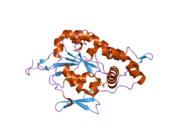HS3ST1
An Error has occurred retrieving Wikidata item for infobox Heparan sulfate glucosamine 3-O-sulfotransferase 1 is an enzyme that in humans is encoded by the HS3ST1 gene.[1][2]
Function
Heparan sulfate biosynthetic enzymes are key components in generating a myriad of distinct heparan sulfate fine structures that carry out multiple biologic activities. The enzyme encoded by this gene is a member of the heparan sulfate biosynthetic enzyme family. It possesses both heparan sulfate glucosaminyl 3-O-sulfotransferase activity, anticoagulant heparan sulfate conversion activity, and is a rate limiting enzyme for synthesis of anticoagulant heparan. This enzyme is an intraluminal Golgi resident protein.[2]
Clinical significance
Polymorphisms in HS3ST1 appear to be a risk factor for developing Alzheimer's disease.[3]
References
- ^ Shworak NW, Liu J, Petros LM, Zhang L, Kobayashi M, Copeland NG, Jenkins NA, Rosenberg RD (February 1999). "Multiple isoforms of heparan sulfate D-glucosaminyl 3-O-sulfotransferase. Isolation, characterization, and expression of human cdnas and identification of distinct genomic loci". The Journal of Biological Chemistry. 274 (8): 5170–84. doi:10.1074/jbc.274.8.5170. PMID 9988767.
- ^ a b "Entrez Gene: HS3ST1 heparan sulfate (glucosamine) 3-O-sulfotransferase 1".
- ^ Witoelar A, Rongve A, Almdahl IS, et al. (2018-12-27). "Meta-analysis of Alzheimer's disease on 9,751 samples from Norway and IGAP study identifies four risk loci". Scientific Reports. 8 (1): 18088. Bibcode:2018NatSR...818088W. doi:10.1038/s41598-018-36429-6. PMC 6308232. PMID 30591712.
Further reading
- Razi N, Lindahl U (May 1995). "Biosynthesis of heparin/heparan sulfate. The D-glucosaminyl 3-O-sulfotransferase reaction: target and inhibitor saccharides". The Journal of Biological Chemistry. 270 (19): 11267–75. doi:10.1074/jbc.270.19.11267. PMID 7744762.
- Liu J, Shworak NW, Fritze LM, Edelberg JM, Rosenberg RD (October 1996). "Purification of heparan sulfate D-glucosaminyl 3-O-sulfotransferase". The Journal of Biological Chemistry. 271 (43): 27072–82. doi:10.1074/jbc.271.43.27072. PMID 8900198.
- Shworak NW, Liu J, Fritze LM, Schwartz JJ, Zhang L, Logeart D, Rosenberg RD (October 1997). "Molecular cloning and expression of mouse and human cDNAs encoding heparan sulfate D-glucosaminyl 3-O-sulfotransferase". The Journal of Biological Chemistry. 272 (44): 28008–19. doi:10.1074/jbc.272.44.28008. PMID 9346953.
- Liu J, Shworak NW, Sinaÿ P, Schwartz JJ, Zhang L, Fritze LM, Rosenberg RD (February 1999). "Expression of heparan sulfate D-glucosaminyl 3-O-sulfotransferase isoforms reveals novel substrate specificities". The Journal of Biological Chemistry. 274 (8): 5185–92. doi:10.1074/jbc.274.8.5185. PMID 9988768.
- Hernaiz M, Liu J, Rosenberg RD, Linhardt RJ (September 2000). "Enzymatic modification of heparan sulfate on a biochip promotes its interaction with antithrombin III". Biochemical and Biophysical Research Communications. 276 (1): 292–7. doi:10.1006/bbrc.2000.3453. PMID 11006120.
- Edavettal SC, Carrick K, Shah RR, Pedersen LC, Tropsha A, Pope RM, Liu J (April 2004). "A conformational change in heparan sulfate 3-O-sulfotransferase-1 is induced by binding to heparan sulfate". Biochemistry. 43 (16): 4680–8. doi:10.1021/bi0499112. PMID 15096036.
External links
- Overview of all the structural information available in the PDB for UniProt: O14792 (Human Heparan sulfate glucosamine 3-O-sulfotransferase 1) at the PDBe-KB.
- Overview of all the structural information available in the PDB for UniProt: O35310 (Mouse Heparan sulfate glucosamine 3-O-sulfotransferase 1) at the PDBe-KB.

